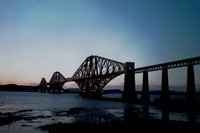Forth Bridge (railway)
|
|
- For the nearby road bridge, see Forth Road Bridge.
Bb-forthrailbridge.jpg
1pound-forth_bridge2004-reverse.jpg
The Forth Bridge is a railway bridge over the Firth of Forth in the east of Scotland, to the east of the Forth Road Bridge, and 14km (9 miles) west of Edinburgh. It is often, and erroneously, called the "Forth Rail Bridge" after the construction of the Forth Road Bridge as a means of distinguishing between the two bridges.
| Contents |
History
Construction of an earlier bridge, designed by Sir Thomas Bouch, got as far as the laying of the foundation stone, but was stopped after the failure of another his works, the Tay Bridge. On Bouch's death, the project was handed over to Sir John Fowler and Sir Benjamin Baker, who designed a structure that was then built by Sir William Arrol's company between 1883 and 1890. Baker - "one of the most remarkable civil engineers Britain ever produced" - and his colleague Allan Stewart receive the major credit for design and overseeing construction work.
Construction
The bridge is, even today, regarded as an engineering marvel. It is 2.5 km (1.5 miles) in length, and the track is elevated 46 m (approx. 150 ft) above high tide. It consists of two main spans of 1,710 ft, two side spans of 675 ft, 15 approach spans of 168 ft and five of 25 ft. The main spans comprise two 680 feet cantilever arms supporting a central 350 ft span girder bridges. The three great four-tower cantilever structures are 340 ft (104 m) tall, each 70 ft diameter foot resting on separate foundations. The southern group of foundations had to be constructed as caissons under compressed air, to a depth of 90 ft. 57 lives were lost during construction; more than 51,000 tons of steel were used, as well as 18,122 m3 of granite and 8M rivets. The bridge was opened by the Prince of Wales, later King Edward VII, who drove home the last rivet, which was gold plated and suitably inscribed. A contemporary materials analysis of the bridge, circa 2002, found that the steel in the bridge is of good quality, with little variation.
The use of the cantilever in bridge design was not a new idea, but the scale of Baker's undertaking was a real pioneering effort, afterwards extensively followed in different parts of the world. Much of the work done was without precedent, including calculations for incidence of erection stresses, provisions made for reducing future maintenance costs, calculations for wind pressures made evident by the Tay Bridge disaster, the effect of temperature stresses on the structure, and so on.
Painting the Forth Bridge
Although modern lightweight trains put fewer stresses on the bridge than the earlier heavy steam trains, the bridge is reputed to need constant maintenance. "Painting the Forth bridge" is a colloquial term for a never-ending task (a modern rendering of the myth of Sisyphus), coined on the erroneous belief that there was ever a time in the history of the bridge when repainting was required and commenced immediately upon finishing the last repainting job. According to a 2004 New Civil Engineer report on contemporary maintenance, such a practice never existed, although it is the case that under British Rail management, and before, the bridge had a permanent maintenance crew.
A contemporary repainting of the bridge commenced with a contract award in 2002, for a schedule of work expected to continue until March 2009, involving the application of 20,000 m2 of paint at a cost estimate of £10M a year.
References
- Charles Matthew Norrie (1956). Bridging the Years - a short history of British Civil Engineering. Edward Arnold (Publishers) Ltd.
- New Civil Engineer 5th February 2004, page 18.
External links
- Forth Bridges Visitor Centre Trust - Rail Bridge Main (http://www.forthbridges.org.uk/railbridgemain.htm)ca:Pont de Forth

